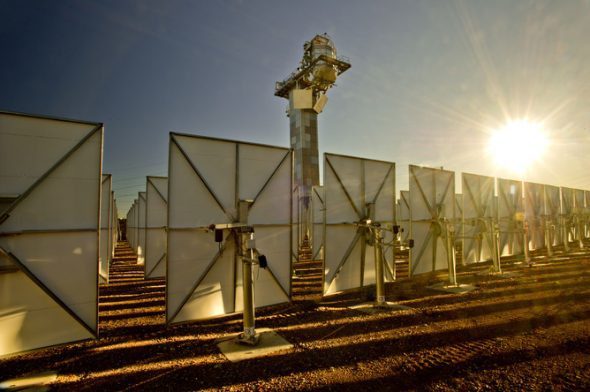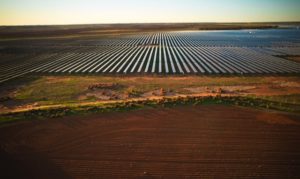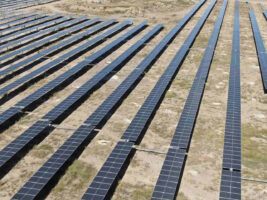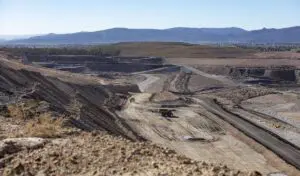Australia’s states and territories have vowed to work together to unblock the nation’s large-scale renewables market, at a joint meeting on climate change in Adelaide on Monday.
Headed up by ACT environment minister Simon Corbell, ministers from seven different jurisdictions, including South Australia, Victoria and Queensland, agreed to collaborate on a sub-national level to boost renewables uptake, energy efficiency strategies and climate adaptation policies, including through the establishment of a senior officer level working group.
One of the main focuses of the meeting was on the opportunity for the states to develop joint policies to drive uptake in renewable energy, including large-scale solar and wind projects. Top of the agenda was adopting the reverse auction systems successfully deployed by the ACT for 200MW of wind and 40MW of solar to date.
The agreement between the states comes as federal Renewable Energy Target negotiations remain stalled, despite an offer of compromise from federal Labor of a 33,000GWh target.
As we reported here on Monday, the compromise figure was proposed late last week by Liberal Party back bencher Dan Tehan, as a middle ground to the Coalition’s ‘final offer’ of 32,000GWh, and Labor’s 33,500GWh – both of which amount to a big step down from the legislated target of 41,000GWh.
Australia’s large-scale renewables industry is particularly keen for a resolution to the RET stalemate which, after more than a year of uncertainty, has seen investment in the sector fall by more than 90 per cent.
But according to a new study released on Monday by Beyond Zero Emissions, the consequences of Australia missing the boat on renewable energy would reach far beyond the industry itself.

The BZE report predicts that Australia has a 50 per cent chance of systemic economic crisis, caused by ignoring the global shift to renewables.
It warns that without changing the Australian investment focus towards cleaner energy, the country is on course for “systemic economic decline”; which means high unemployment, high debt, and deep recession.
“There are a number of risks facing the Australian economy,” said Gerard Drew, BZE’s director of research. “Being unprepared and wrong footed by the global transition to a clean economy is a major risk that can be avoided by our domestic actions.
“Transitioning to a clean energy economy will take time. The longer the government delays, the greater the risk to the economy, and the greater the cost all Australians will have to bear,” Drew says.
“Based on the government’s own projections, Australia’s reliance on increasing exports of fossil fuels could reduce export revenue by $100 billion each year by 2030.
“Australia urgently needs a new direction to ensure prosperity into the future, taking part in the global transition to clean energy – not fighting against it. This will protect our environment, our international reputation and the impacts of an economic crisis.”
Which brings us back to why a decision on the RET is so important. But not everyone is happy with the proposed compromise figure: Australian Solar Council chief, John Grimes, on Monday said that a 33,000GWh target would be a disaster for big solar, with most of the remaining capacity likely to be taken up by wind projects.
“This (would be) a poor outcome for Australia. It locks us into a single technology and ignores Australia’s solar potential,” Grimes said in a statement.
But, as the ACT has shown through its hugely successful solar auctions scheme, there are ways around the federal policy roadblocks.
“There is a lot that can be achieved by state and territory governments taking the lead on climate change,” Corbell said on Monday.
“The ACT is a leader nationally and internationally when it comes to action on climate change and we are happy to share our experience with our state and territory counterparts.
“The ACT can share information on our award winning reverse auction process, which has produced fantastic results in achieving record low prices for renewable energy.
“Likewise we can work with our interstate colleagues to find ways to work together across borders to reduce duplication and create consistency.”
The meeting, which was also attended by the executive secretary of the UN Framework Convention on Climate Change (UNFCCC), Christiana Figueres, agreed on three other key focus areas for further action:
– to identify approaches to harmonise the delivery of energy efficiency schemes to further reduce costs for households and businesses and to improve consistency across States and Territories;
– to improve information sharing and best practice delivery in adaptation to support community resilience in responding to the impacts of climate change;
– to share information on emission reduction targets and how individual jurisdictions are tracking against these targets.
“By working together, our states and territories can supplement federal government policies to really take advantage of the economic benefits that come with moving to a decarbonised future,” said Corbell.
“As Ms Figueres has rightly pointed out, international experience has shown that growth in GDP is no longer linked to growth in greenhouse gas emissions.
“Around the world countries are showing that they can grow their economies while decreasing greenhouse gas emissions.
“Here in Australia we are fortunate to have the best renewable energy resources in the world and we should be leaders internationally.”
Independent Senator Nick Xenophone, meanwhile, called for more than just changes to numbers in a resolution to the RET. He repeated his concern about too much wind energy, saying that big solar and tidal energy was being displaced by the make-up of the scheme.
He called for the RET to give weighting to technologies that provided energy at peak time – such as big solar, but also battery storage. He pointed to the release of the Tesla Powerwall as one example of the rapid change in the energy industry that could be recognised in the RET policy.
He said wind energy was “intermittent and unreliable.” Much of it was produced at night, and on high fire danger days. “Weighting should be given to techologies that can provide power at peak times,” he said, adding that he was disappointed that the Anti Dumping Commission did not recommend high duties on imported solar modules.










